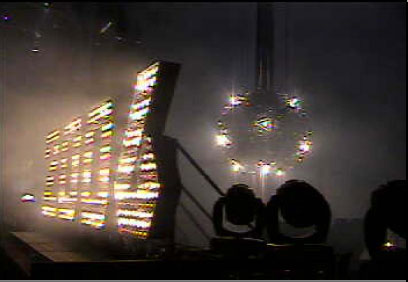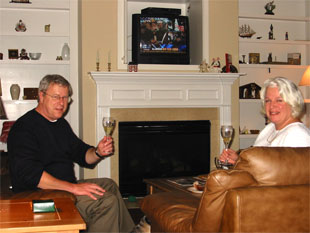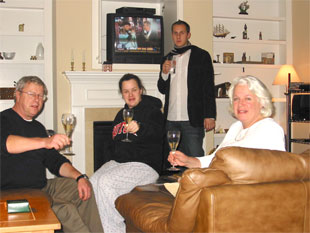



We’ll take a cup of kindness yet …
Happy New Year 2006 from the Skellys! May the year lift up your heart and fill your spirit with hope and joy. Our New Year’s wish is to run into some of you before it progresses too far.
"Auld Lang Syne" is one of the best-known songs in English-speaking countries. Yet, it is sometimes referred to jokingly as "the song that nobody knows," since many people can recall the melody easily but know only a fraction of the words. It is usually sung each year on New Year's Eve at midnight and signifies the start of a new year.
Bandleader Guy Lombardo popularized the association of the song with New Year's Eve, through his annual broadcasts on radio and TV, beginning in 1929 [through 1976]. However, he did not invent or first introduce the custom. The ProQuest newspaper archive has articles going back to 1896 that describe revellers on both sides of the Atlantic singing the song to usher in the New Year. [Ed: Lombardo died in 1977. A popular quip for years after was that when Guy Lombardo died he took New Year’s with him.]
It is also used as a graduation song and a funeral song in Taiwan, symbolizing an end or a goodbye.
In Japan, many stores play it to usher customers out at the end of a business day.
In the United Kingdom, it is played at the close of the annual Congress (conference) of the Trades Union Congress.
Before the composition of Aegukga, the lyrics of Korea's national anthem were sung to the tune of this song.
Also, before 1972, it was the tune for the anthem of The Maldives (with the current words).
The University of Virginia's fight song (The Good Old Song) also carries the same tune.
In Portugal, this song is used to mark a farewell, especially in the boy scout movement.
In the Indian Armed Forces the band plays this song as the farewell song, during the passing out parade of the recruits.
In October 2000, it was played when the body of former Canadian prime minister Pierre Trudeau left Parliament Hill in Ottawa for the last time, going to Montreal for the state funeral.
"Auld Lang Syne" was transcribed and published by the Scottish poet Robert Burns (1759-96), based on earlier Scots ballads. Robert Burns forwarded a copy of the original song to the British Museum with the remark, "The following song, an old song, of the olden times, and which has never been in print, nor even in manuscript until I took it down from an old man's singing, is enough to recommend any air." The tune Burns suggested is not the tune we use today.
Scots "Auld Lang Syne" was equivalent to English "old long since" and can best be translated as "times gone by". In Scots "'Syne" is pronounced identically to the English word sign, (IPA [sa?n]) — not zine [zaIn] as many people sing it.
Singing the song on Hogmanay or New Year's Eve is a Scottish custom.
The meter of this song (technically "common meter double" or 8-6-8-6-8-6-8-6) is identical to that of America the Beautiful. The two songs can be sung perfectly with lyrics interchanged.
Bandleader Guy Lombardo popularized the association of the song with New Year's Eve, through his annual broadcasts on radio and TV, beginning in 1929 [through 1976]. However, he did not invent or first introduce the custom. The ProQuest newspaper archive has articles going back to 1896 that describe revellers on both sides of the Atlantic singing the song to usher in the New Year. [Ed: Lombardo died in 1977. A popular quip for years after was that when Guy Lombardo died he took New Year’s with him.]
It is also used as a graduation song and a funeral song in Taiwan, symbolizing an end or a goodbye.
In Japan, many stores play it to usher customers out at the end of a business day.
In the United Kingdom, it is played at the close of the annual Congress (conference) of the Trades Union Congress.
Before the composition of Aegukga, the lyrics of Korea's national anthem were sung to the tune of this song.
Also, before 1972, it was the tune for the anthem of The Maldives (with the current words).
The University of Virginia's fight song (The Good Old Song) also carries the same tune.
In Portugal, this song is used to mark a farewell, especially in the boy scout movement.
In the Indian Armed Forces the band plays this song as the farewell song, during the passing out parade of the recruits.
In October 2000, it was played when the body of former Canadian prime minister Pierre Trudeau left Parliament Hill in Ottawa for the last time, going to Montreal for the state funeral.
"Auld Lang Syne" was transcribed and published by the Scottish poet Robert Burns (1759-96), based on earlier Scots ballads. Robert Burns forwarded a copy of the original song to the British Museum with the remark, "The following song, an old song, of the olden times, and which has never been in print, nor even in manuscript until I took it down from an old man's singing, is enough to recommend any air." The tune Burns suggested is not the tune we use today.
Scots "Auld Lang Syne" was equivalent to English "old long since" and can best be translated as "times gone by". In Scots "'Syne" is pronounced identically to the English word sign, (IPA [sa?n]) — not zine [zaIn] as many people sing it.
Singing the song on Hogmanay or New Year's Eve is a Scottish custom.
The meter of this song (technically "common meter double" or 8-6-8-6-8-6-8-6) is identical to that of America the Beautiful. The two songs can be sung perfectly with lyrics interchanged.
The above shamelessly lifted from “The Free Dictionary by Farlex”
http://encyclopedia.thefreedictionary.com/auld+lang+syne
(It looks like they may have shamelessly lifted it from Wikipedia.com)
You want more, including information on the melody? Try http://mysongbook.de/msb/songs/a/auldlang.html
You want more, including information on the melody? Try http://mysongbook.de/msb/songs/a/auldlang.html